

Abel5.pdf. Teach to Students' Learning Styles. It is always important for teachers to teach to their students’ learning styles but this becomes crucial when teaching English language learners.
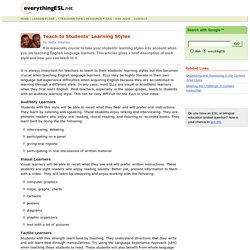
ELLs may be highly literate in their own language but experience difficulties when acquiring English because they are accustomed to learning through a different style. In any case, most ELLs are visual or kinethetic learners when they first learn English. Most teachers, especially in the upper grades, teach to students with an auditory learning style. This can be very difficult for the ELLs in your class. Auditory Learners. What the Good Language Learner Can Teach Us. What makes a language learner an effective acquirer of a foreign language?
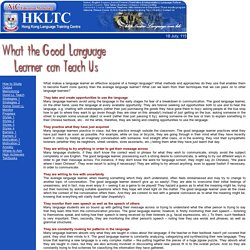
What methods and approaches do they use that enables them to become fluent more quickly than the average language learner? What can we learn from their techniques that we can pass on to other language learners? They take and create opportunities to use the language Many language learners avoid using the language in the early stages for fear of a breakdown in communication. The Good Language Learner's Strategies 1. As I observe students of Chinese, I notice that they use different learning strategies, some which are more effective than others.

What are some of their good strategies which will help you acquire Chinese faster than the average student? Let's first look at some memory strategies. The Good Language Learner's Strategies 2. In the article 'The Good Language Learner's Strategies 1' we looked at memory strategies.

In this article we will be thinking about communication strategies, i.e. those learning strategies which help make conversation easier and more profitable in terms of gaining in fluency. Here are some useful ideas: Create Your Own Personalized Dialogues: re-writing the textbook dialogues, substituting your own personal details, will help vocabulary stick quicker.
Some Good Language Learners. Here are profiles on three good language learners and three poor language learners: Tim -- An Outstanding Language Learner He worked hard at his studies.
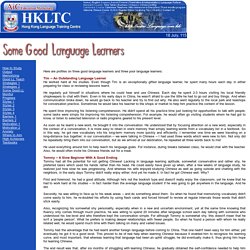
Even though Tim is an exceptionally gifted language learner, he spent many hours each day in either preparing for class or reviewing lessons learnt. He regularly put himself in situations where he could hear and use Chinese. Each day he spent 2-3 hours visiting his local friendly shopkeepers to chat with them. Even in his early days in China, he wasn't afraid to use the little he had to go out and buy things. Learning Styles. In recent years in the area of teaching languages there has been a shift in focus from how the teacher should teach to how the student best learns.
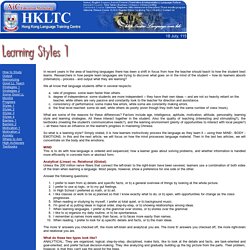
Researchers in how people learn languages are trying to discover what goes on in the mind of the student -- how do learners absorb (internalize) - process - and output what they are learning? We all know that language students differ in several respects: rate of progress: some learn faster than others. degree of independence: some students are more independent -- they have their own ideas -- and are not so heavily reliant on the teacher, while others are very passive and constantly look to the teacher for direction and assistance. consistency of performance: some make few errors, while some are constantly making errors. the final level reached: some do well, while others do poorly (even though they both had the same number of class hours). What are some of the reasons for these differences? So what is a learning style? Analytical (Linear) vs.
How Learners Perceive and Process the Language. How Learners Perceive & Process the Language In the previous article, we looked at the different learning styles of the Analytical learner compared to the Relational learner.
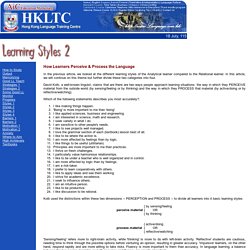
In this article, we will continue on this theme but further divide these two categories into four. David Kolb, a well-known linguist, claims that are there are two ways people approach learning situations: the way in which they PERCEIVE material from the outside world (by sensing/feeling or by thinking) and the way in which they PROCESS that material (by active/doing or by reflective/watching).
Which of the following statements describes you most accurately? : I like making things happen. Kolb used the distinctions within these two dimensions -- PERCEPTION and PROCESS -- to divide all learners into 4 basic learning styles: 'Sensing/feeling' refers more to right-brain activity, while 'thinking' is more to do with left-brain activity. How Learners Use Their Sensory Channels to Process Language. How Learners Use Their Sensory Channels to Process Language In the previous two articles on learning styles, we looked at how the mind perceives and processes language.
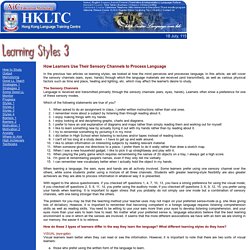
In this article, we will cover the sensory channels (ears, eyes, hands) through which the language materials are received (and transmitted), as well as various physical factors such as time and place, heating and lighting, etc. which may affect the learner's desire to study. The Sensory Channels Language is received and transmitted primarily through the sensory channels (ears, eyes, hands). Learners often show a preference for one of these sensory modes. Which of the following statements are true of you? When asked to do an assignment in class, I prefer written instructions rather than oral ones. When learning a language, the ears, eyes and hands are all actively involved. How the Learner's Personality Affects the Way They Learn. How the Learner's Personality Affects the Way They Learn In the three previous articles, we looked at how the mind and the body process language.
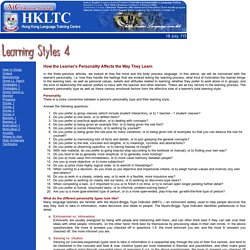
In this article, we will be concerned with the learner's personality, i.e. how they handle the feelings that are evoked during the learning process, what kind of motivation the learner brings to the learning task, as well as personal values, beliefs and attitudes related to learning; whether they prefer to work alone or in groups, and the kind of relationship the learner prefers to have with the teacher and other learners. These are all key factors in the learning process. The learner's personality type as well as these various emotional factors form the affective side of a learner's total learning style.
Personality There is a close connection between a person's personality type and their learning style. Answer the following questions: Do you prefer a) group classes (which include student interaction), or b) 1 teacher - 1 student classes? Overcoming the Barriers 1. When coming to China, we bring a lot of 'baggage' with us.

I'm not referring here to our suitcases and trunks, however, but to our personality make-up. We come with our degrees, diplomas and doctorates to prove that we are intelligent. We may also come with a high MLAT score (MLAT = Modern Language Aptitude Test). This tells us that we are able to learn languages well in a classroom setting. We may come, too, with some previous language learning successes. We also come with our attitudes. Finally, we come with our own individual personalities -- introvert or extrovert, inhibited or outgoing, anxious or carefree.
So let us now take a deeper look at some of these affective factors and see how we can find ways to overcome the negative ones. High Self-Esteem vs. Overcoming the Barriers 2. Perfectionism It is important to note that a perfectionist trait can be either good or bad, depending on how you react to it. The student who says, "I will press on until I get it right" displays a good attitude. Their goal is to achieve as near native-like pronunciation as possible. They therefore continue to work at perfecting the sounds and are willing to take repeated correction until they get it right. However, the student who says, "I will not move on to the next lesson until I have mastered this one perfectly" does not understand that languages are not learnt in that way. Maintaining Motivation During Language School. Maintaining Motivation During Language School For the language learner, motivation is an important topic for the vital reason that the motivated learner will always surpass the unmotivated learner in performance and outcome.
People have an innate need to be competent and effective in their work and motivation is a key factor in helping them reach their goals. Furthermore, learners who leave full-time language study motivated about their Chinese communicative ability are more likely to continue acquiring the language, hence becoming lifelong learners. There are two sources of motivation -- internal and external. Motivation for On-going Language Learning. Motivation for On-going Language Learning after Full-time Language Study Educators tell us that adults tend to be more motivated when effectively learning something they value. Successful mastery of Chinese is a very satisfying feeling! Anxiety in Language Learning. What does Anxiety look like?
Mary found class difficult. Reading out dialogues and drills after the teacher wasn't too difficult, but when having to say something in front of the whole class, she often got stage fright and performed badly. John knew it was best to get out on the street and practice what he had learnt in class. However, when outside and seeing someone just about to talk to him in Chinese, he would freeze and found it difficult to grasp what they were trying to say.
STUDY SKILLS FOR ESL LEARNERS.